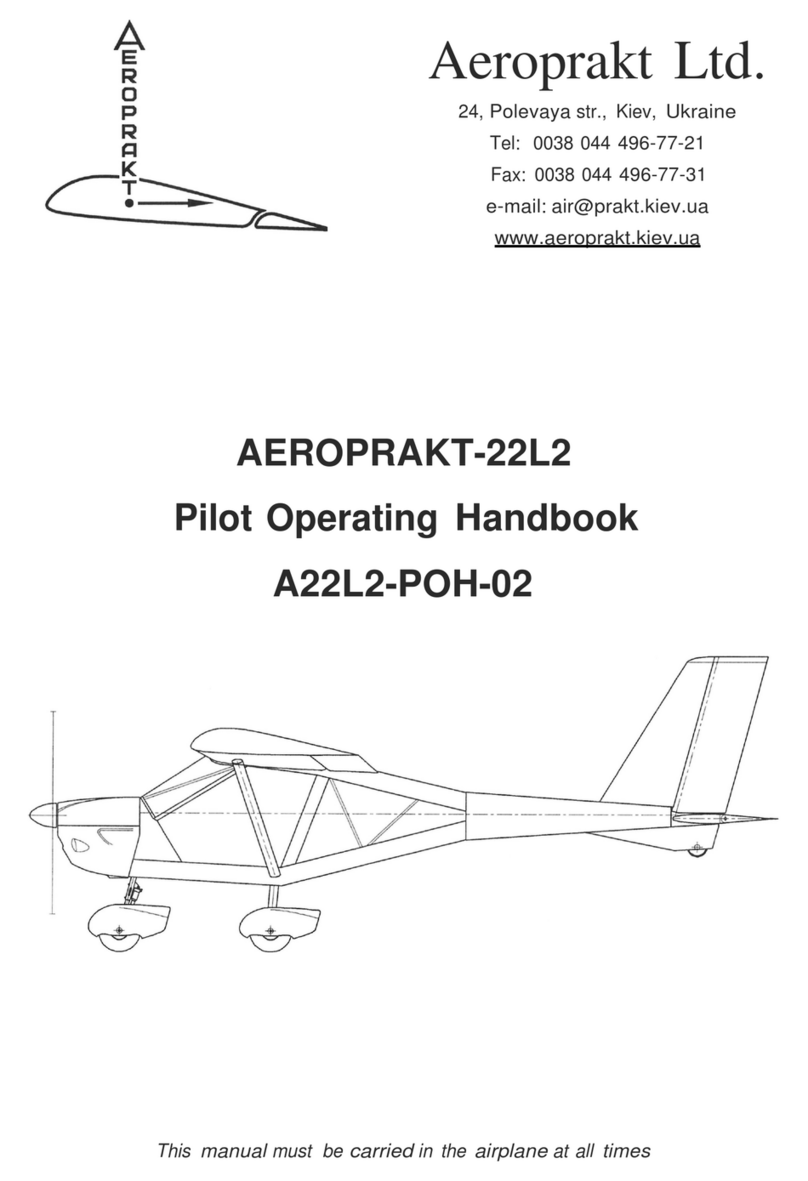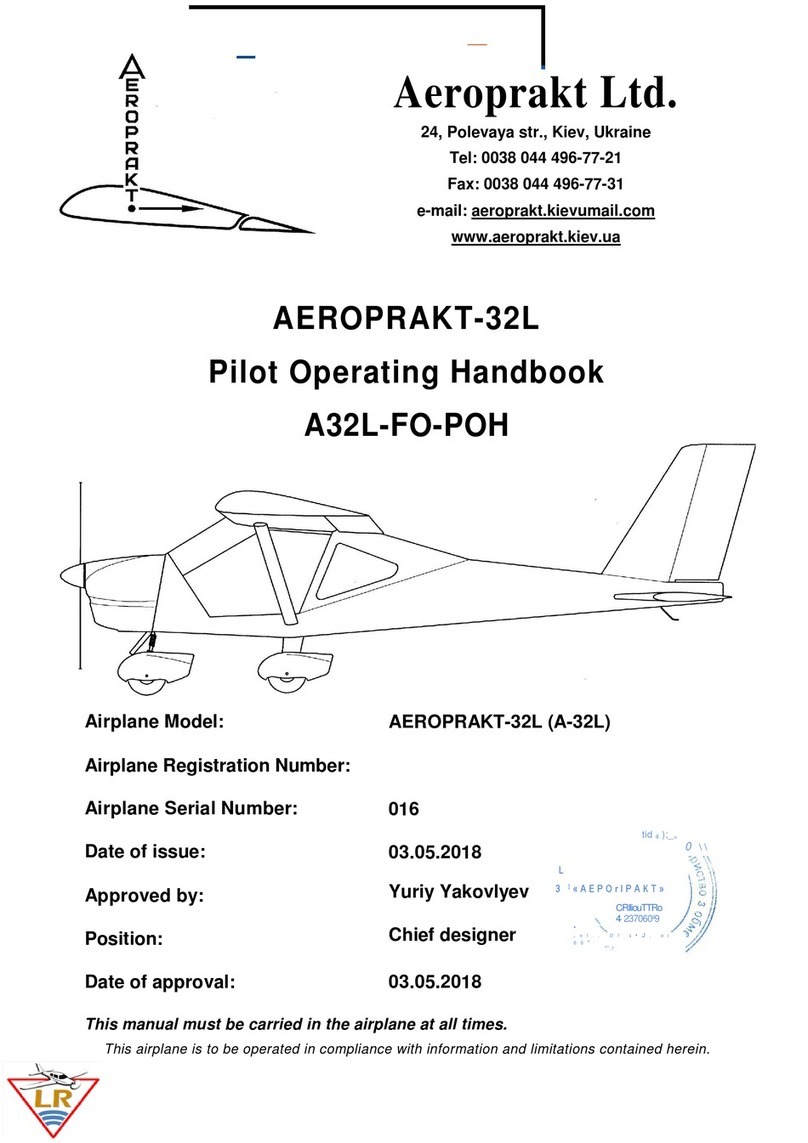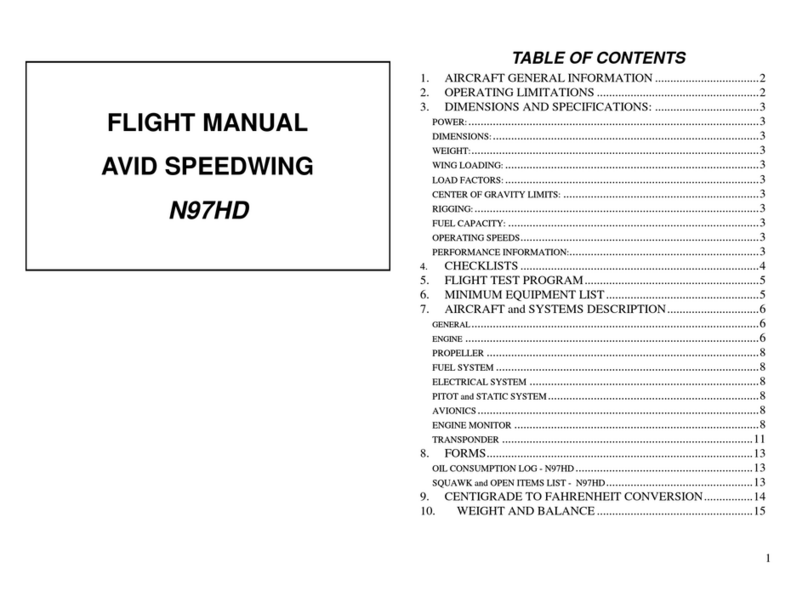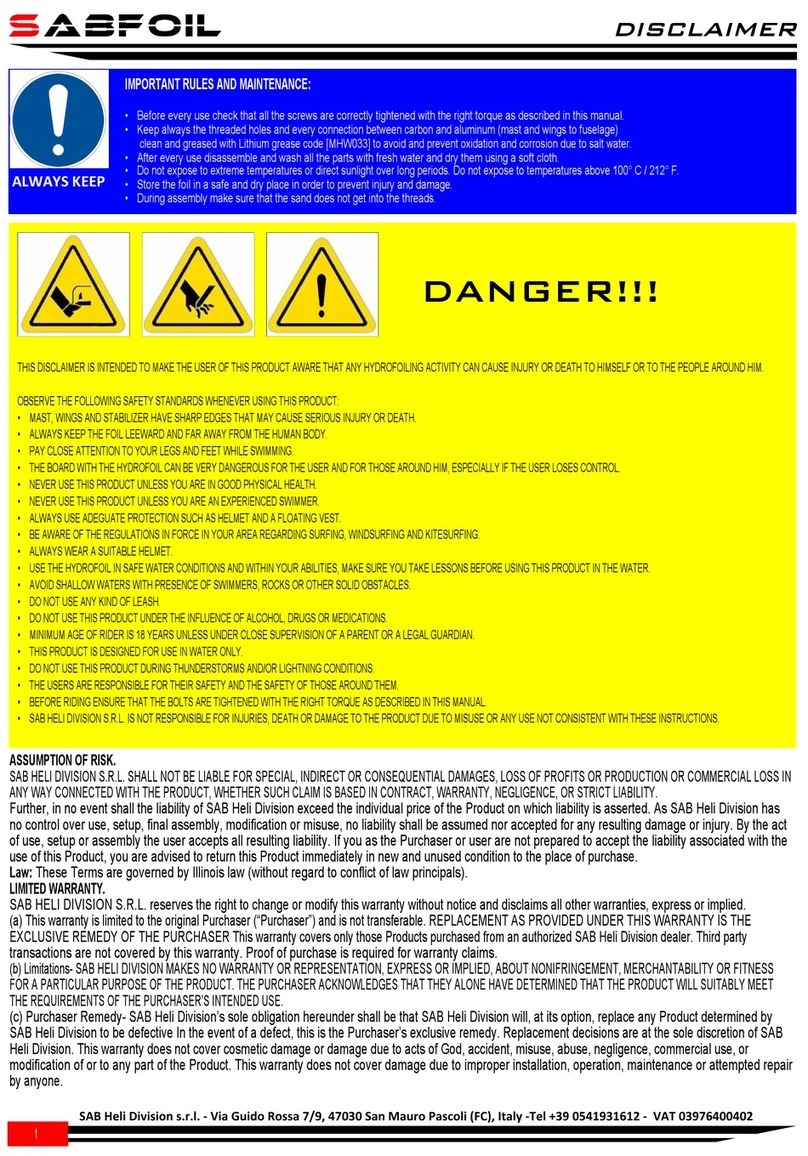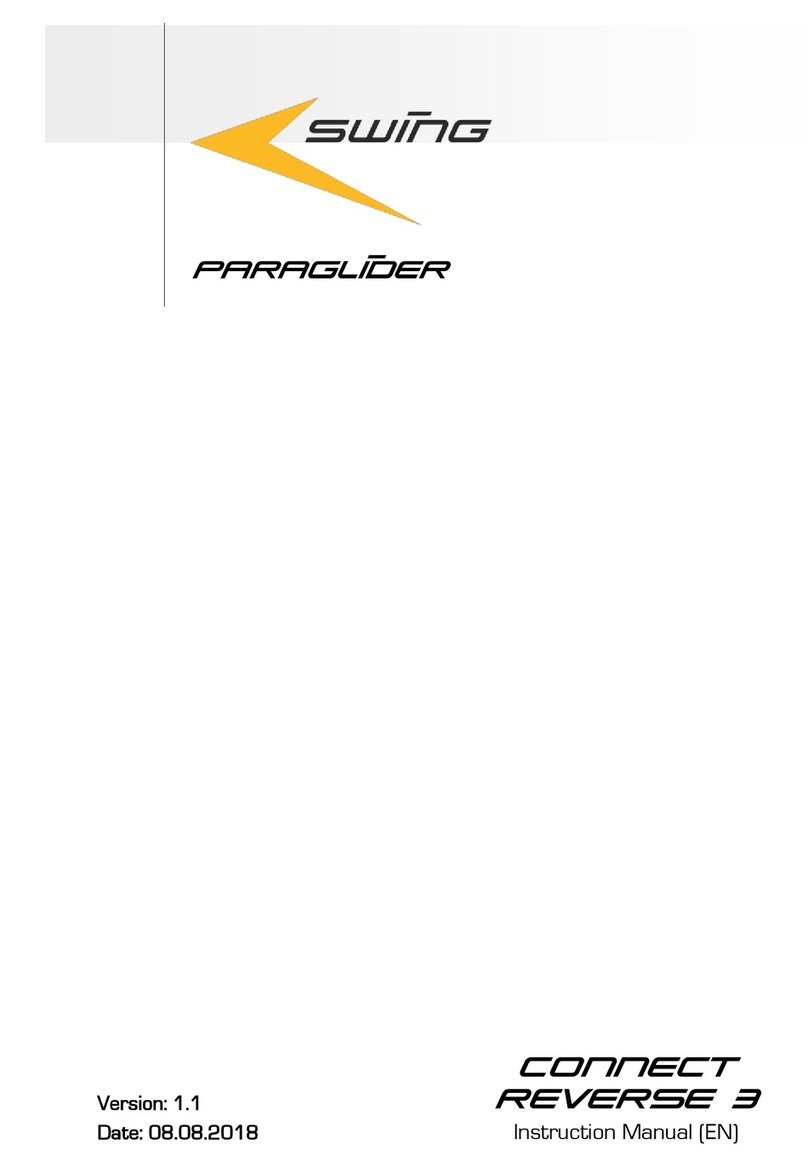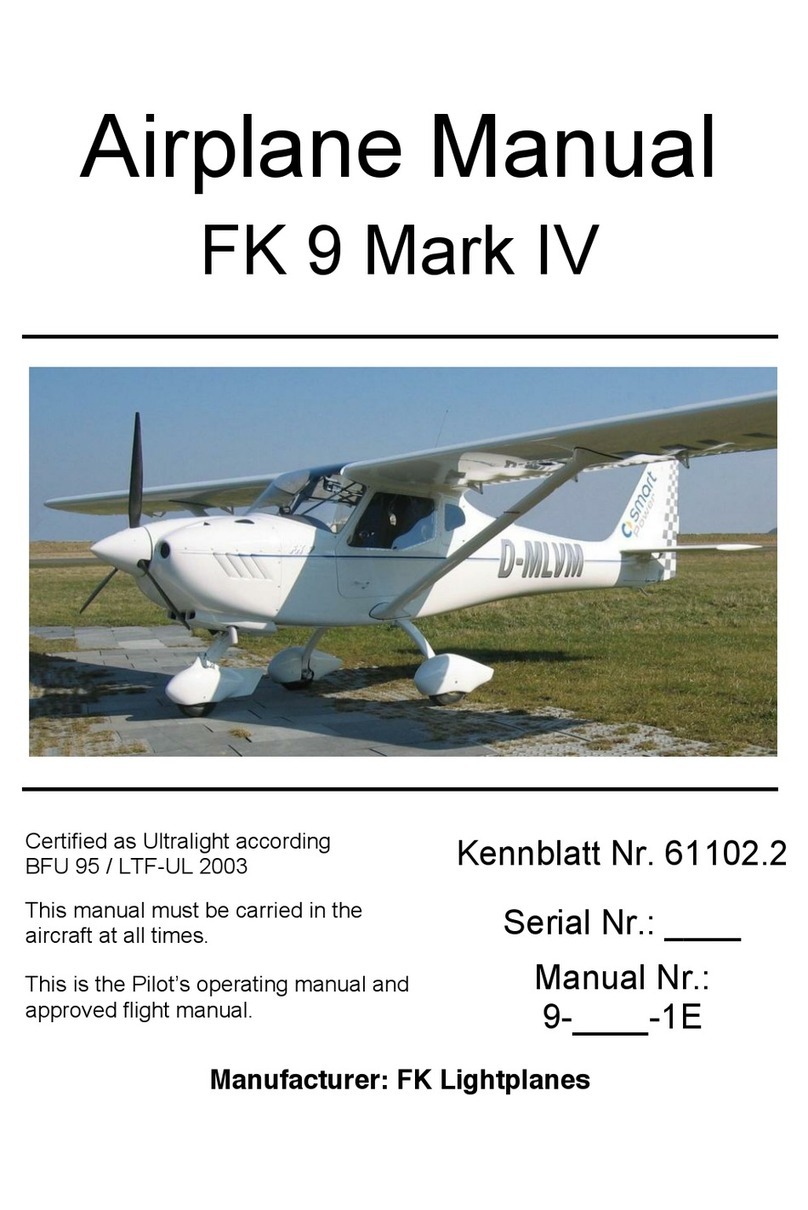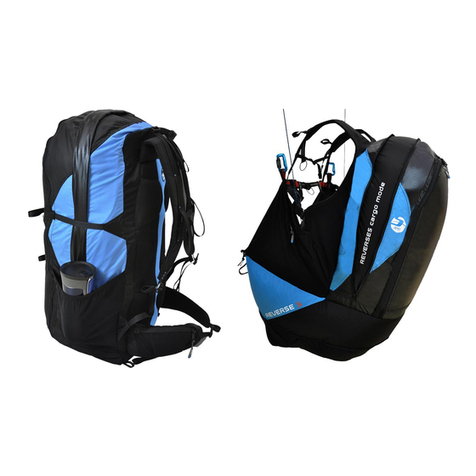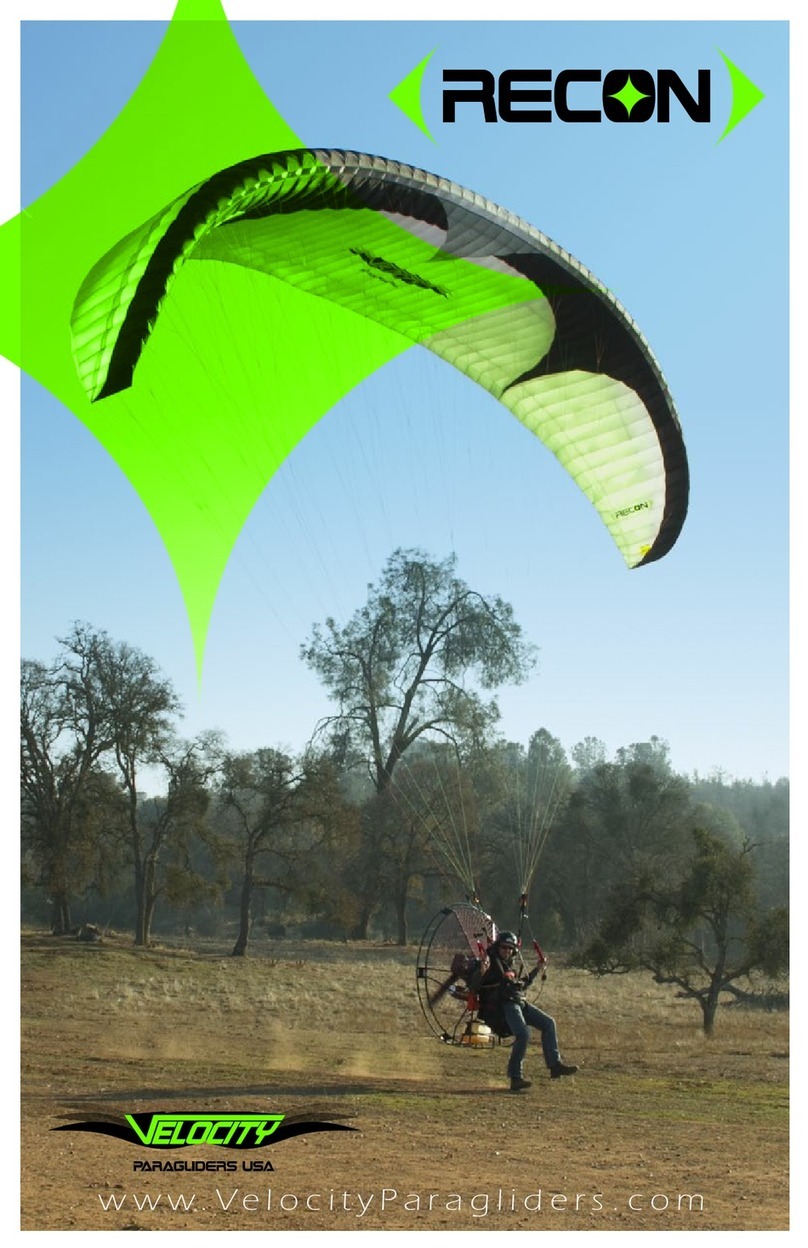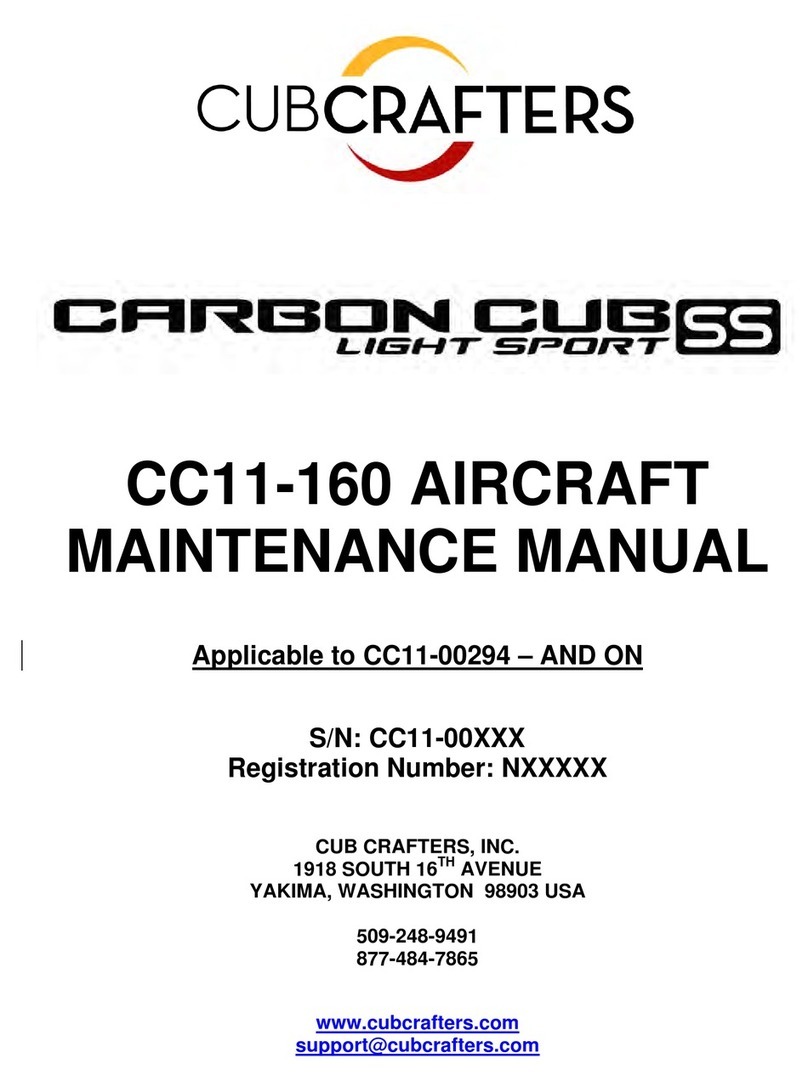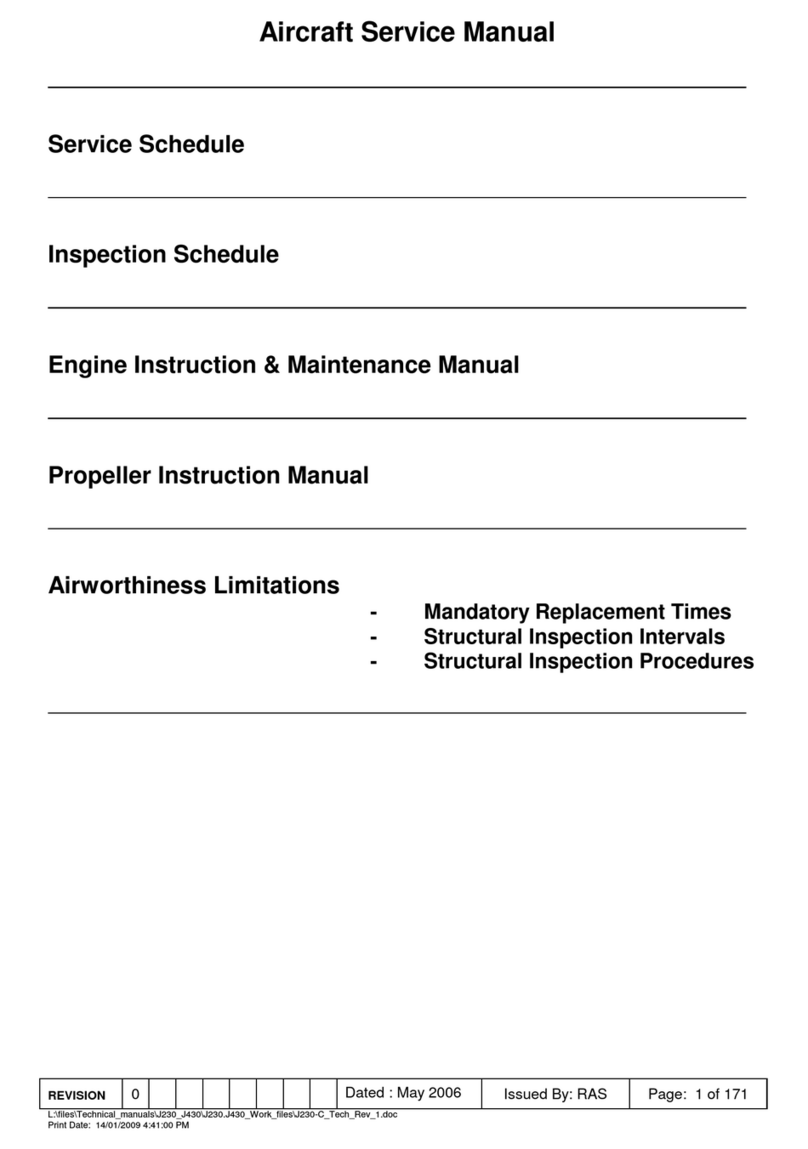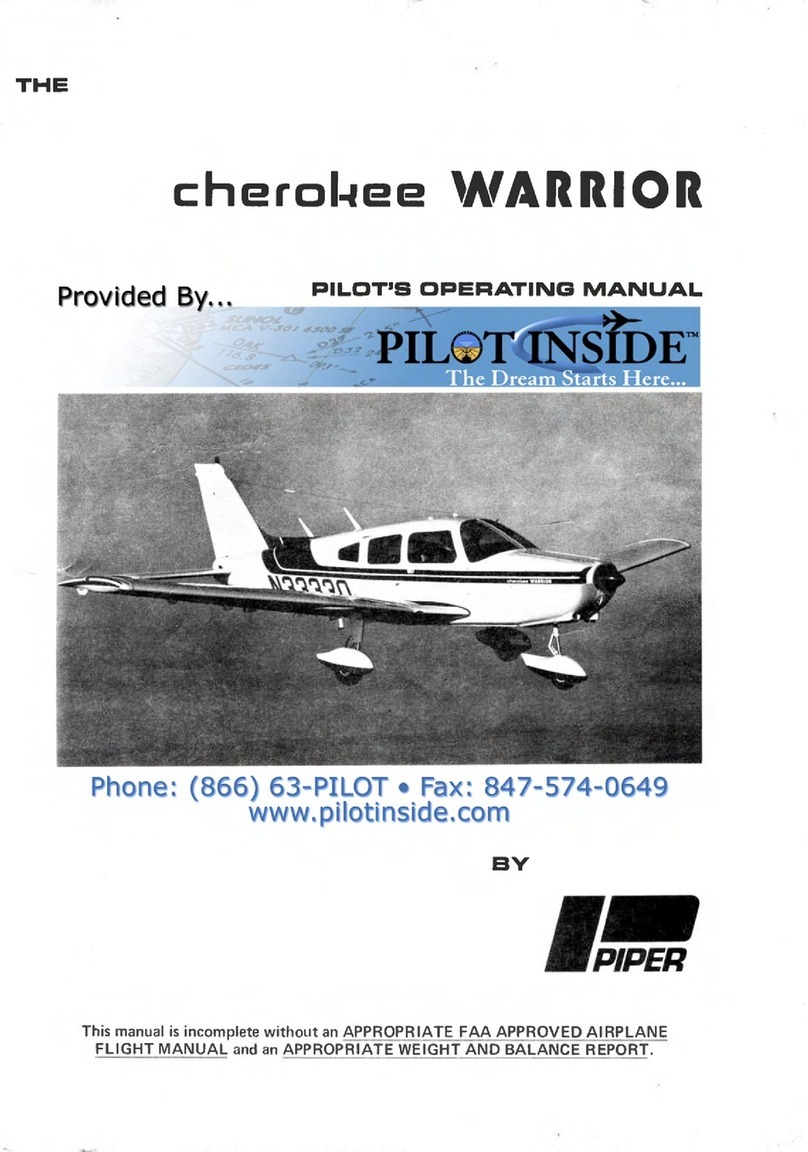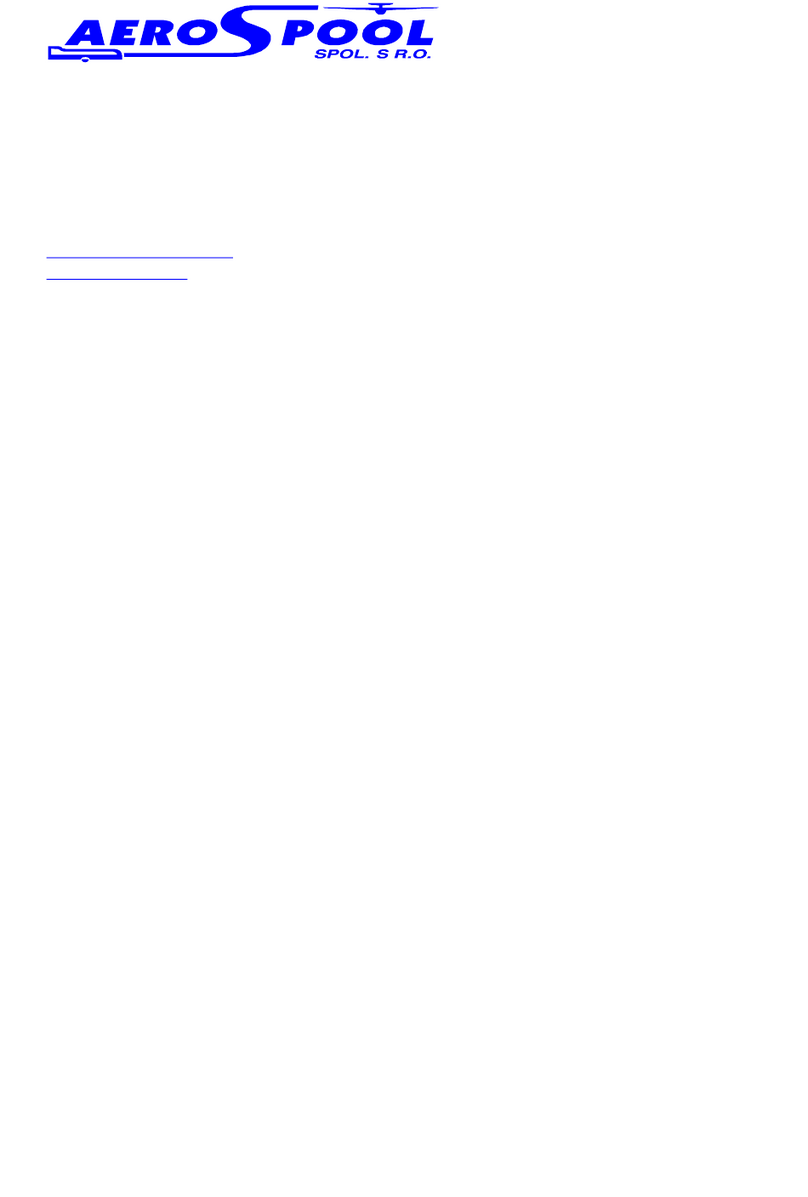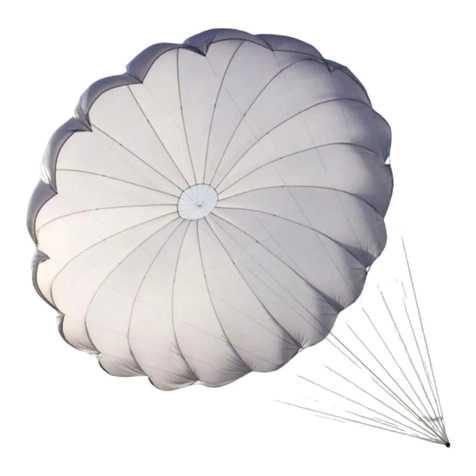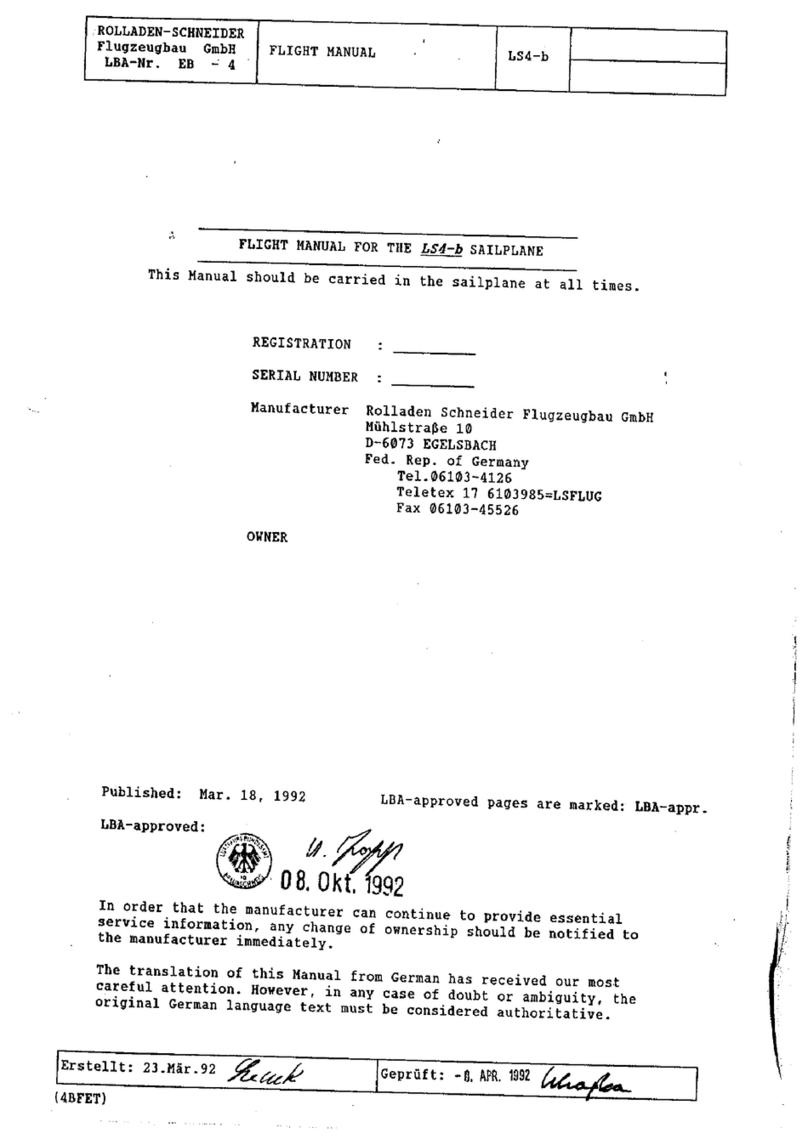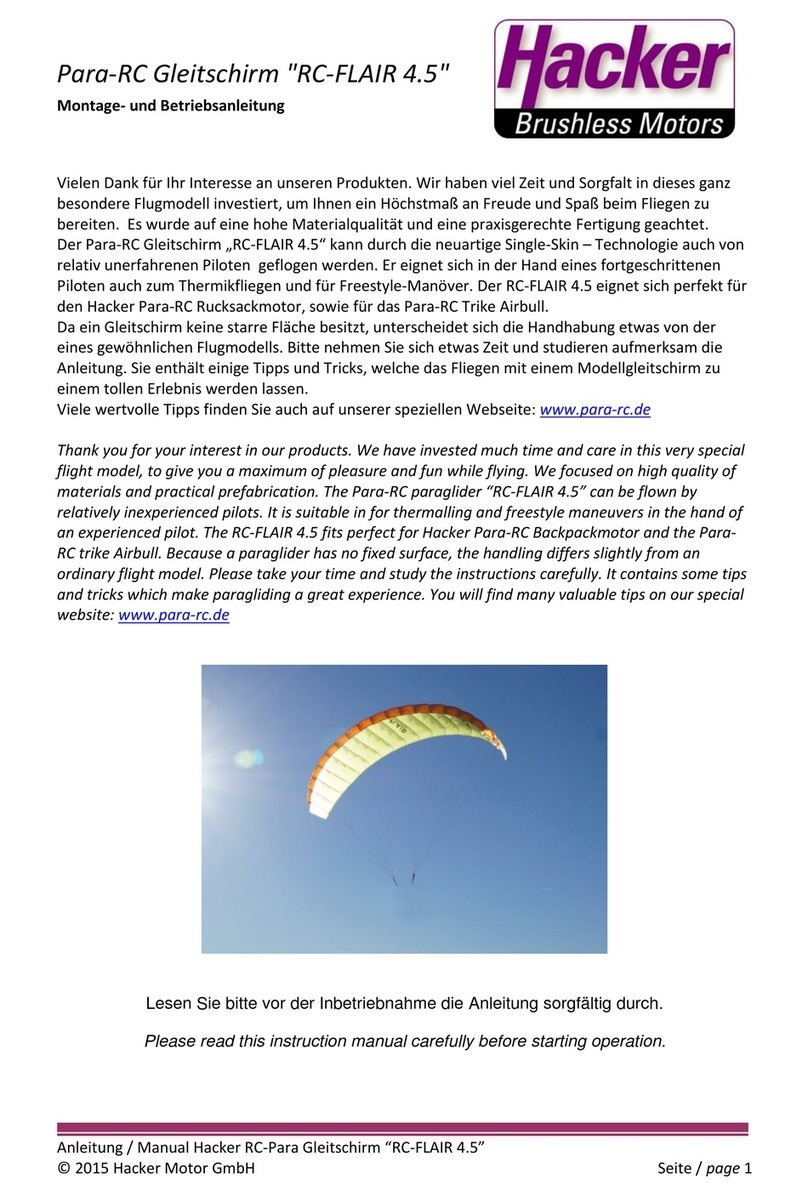AEROPRAKT 22LS Owner's manual

AEROPRAKT-22LS
Pilot Operating Handbook
A22LS-POH-04
Airplane Model: AEROPRAKT-22LS (A-22LS)
Airplane Registration Number: N22FC
Airplane Serial Number: 373
Date of issue: 19.02.2020
Approved by: Yuriy Yakovlyev
Position: Chief designer
Date of approval: 19.02.2020
This manual must be carried in the airplane at all times.

AEROPRAKT-22LS Pilot Operating Handbook A22LS-POH-04
This airplane is to be operated in compliance with information and limitations contained herein.
2

AEROPRAKT-22LS Pilot Operating Handbook A22LS-POH-04
RECORD OF MANUAL REVISIONS
No part of this manual may be reproduced or changed in any manner without a written
consent of the Manufacturer.
Any revision of the present manual, except actual weighing data, must be recorded in the
following table according to information from the Manufacturer.
New or amended text in the revised pages will be indicated by a black vertical line on the left
hand margin, and the Revision No. and the date will be shown on the bottom left hand side
of the page.
Rev. No.
Affected
Section
Affected
Pages
Date
Approval
Date
Date
Inserted
Signature
Table of contents
1 Introduction 5
2 General information 6
2.1 General description of the airplane 6
2.2 Airplane specifications 6
3

AEROPRAKT-22LS Pilot Operating Handbook A22LS-POH-04
3 Limitations 7
3.1 Airspeeds and Airspeed Indicator markings 7
3.2 Service ceiling 8
3.3 Maneuvering load factors 8
3.4 Approved maneuvers 8
3.5 Fuel capacity and type 8
3.6 Engine 9
3.7 Kinds of operation limits 9
3.8 Crosswind limitation 9
4 Emergency procedures 10
4.1 General 10
4.2 Emergency checklists 10
5 Normal Procedures 15
5.1 General 15
5.2 Preflight check 15
5.3 Fuel levels, fuel valve settings and respective actions 17
5.4 Engine starting 18
5.5 Taxiing 18
5.6 Before takeoff 18
5.7 Normal takeoff 19
5.8 Short/soft field takeoff 19
5.9 Climb 19
5.10 Cruise 20
5.11 Approach 20
5.12 Normal landing 20
5.13 Short/soft field landing 21
5.14 Balked landing 21
6 Performance 22
6.1 General 22
6.2 Takeoff and landing distances 22
6.3 Climb performance 22
6.4 Cruise speeds and fuel consumption at various RPM settings 22
7 Weight and Balance and Equipment List 24
7.1 Weight and Balance Chart 24
7.2 Installed equipment list 25
8 Airplane and Systems Descriptions 26
8.1 General 26
4

AEROPRAKT-22LS Pilot Operating Handbook A22LS-POH-04
8.2 Airframe 26
8.3 Landing gear 27
8.4 Engine and its controls 27
8.5 Propeller 27
8.6 Fuel system 28
8.7 Airplane control systems 30
8.8 Instrument panel 36
8.9 Full and static pressure system 38
8.10 Electrical system 39
8.11 Seats and harness belts 46
8.12 Cockpit doors 46
8.13 Baggage container 46
9 Aircraft Ground Handling and Servicing 47
9.1 Introduction 47
9.2 Towing, parking and tie-down instructions 47
9.3 Servicing fuel, oil and coolant 47
9.4 Approved fuel and oil 48
9.5 Cleaning and care 48
9.6 Disassembling and assembling the airplane 48
10 Supplements 51
10.1 General 51
10.2 Engine manual 51
10.3 Avionics and special engine instruments 51
10.4 Recovery system 51
10.5 Floats 51
10.6 List of installed equipment 52
10.7 Actual empty weight and CG position data 53
10.8 Airplane Flight Training Supplement 54
10.9 Airplane Owner Feedback to Manufacturer 57
10.10 Glider and banner towing 58
5

AEROPRAKT-22LS Pilot Operating Handbook A22LS-POH-04
1 Introduction
This Pilot Operating Handbook has been prepared to provide the airplane owner and
operators with information required for the safe and efficient operation of this airplane.
The following ASTM standards have been and/or shall be used for the design, construction
and continued airworthiness of this Aeroprakt-22LS (A-22LS) airplane:
F2245-18 Standard Specification for Design and Performance of a Light Sport Airplane,
F2295-10 Standard Practice for Continued Operational Safety Monitoring of a Light Sport
Aircraft,
F2316-12 Standard Specification for Airframe Emergency Parachutes,
F2339-06 Standard Practice for Design and Manufacture of Reciprocating Spark Ignition
Engines for Light Sport Aircraft,
F2506-13 Standard Specification for Design and Testing of Light Sport Aircraft Propellers,
F2745-15 Standard Specification for Required Product Information to be Provided with an
Airplane,
F2746-14 Standard Specification for Pilot's Operating Handbook (POH) for Light Sport
Airplane,
F2972-15 Standard Specification for Light Sport Aircraft Manufacturer’s Quality Assurance
System.
This A-22LS airplane was manufactured by:
AEROPRAKT Manufacturing Sp. z o.o..
Address: ul. Zadziele 10.
32-406 Zakliczyn,
POLAND
Tel.: +48 602 215854
E-mail: aleksander.opoczynski@aeroprakt.pl
Should the original manufacturer of the aircraft lose its ability to support this aircraft make
and model, contact:
Aeroprakt USA
Dennis Long
1 SE Searcy Municipal Airport
Searcy, AR. 72143
Aeroprakt.usa@gmail.com
+1 901-356-5175
6

AEROPRAKT-22LS Pilot Operating Handbook A22LS-POH-04
2 General information
2.1 General description of the airplane
AEROPRAKT-22LS (A-22LS) is a two-seat, high-wing strut braced monoplane of "classic"
aerodynamic layout with closed cockpit, non-retractable landing gear with steerable nose
wheel, Rotax-912 engine with tractor three-blade on-ground adjustable pitch propeller.
AEROPRAKT-22LS is approved for flying in VFR, simple meteorological conditions.
AEROPRAKT-22LS is certified in the LSA (Light Sport Airplane) category.
2.2 Airplane specifications
Specification
US units
Metric
Wing span
31 ft 4 in
9.55 m
Wing area
136 sq. ft
12.62 m²
Length
20 ft 5 in
6.23 m
Height
8 ft 2 in
2.47 m
Wheel base
4 ft 2 in
1.26 m
Wheel track
5 ft 7 in
1.71 m
Gross weight (Maximum Take-Off Weight, MTOW)
1320 lb.
600 kg
Top speed at sea level, ISA conditions (with wheels landing gear)
114 mph
183 km/h
Cruising speed at 1000 ft, ISA conditions, and engine RPM:
4000
68 mph
110 km/h
4600
92 mph
148 km/h
4800
97 mph
156 km/h
5000
100 mph
161 km/h
5200
104 mph
167 km/h
Range with full tanks (with 2x45 l tanks, 30 min. reserve) at 1000
ft, ISA conditions, 4000 RPM (with wheels landing gear)
609 mi
981 km
Best angle of climb speed (V
X
), IAS
56 mph
90 km/h
Best rate of climb speed (V
Y
), IAS
62 mph
100 km/h
Stalling speed at MTOW, flaps up (V
S
), IAS
48 mph
77 km/h
Stalling speed at MTOW, full flaps (V
S0
), IAS
37 mph
60 km/h
Maximum engine power at 5800 RPM (5 minutes limit)
100 hp
73.5 kW
Total fuel capacity (standard tanks)
23.8 US gal
90 l
Usable fuel (standard tanks)
23.3 US gal
88 l
Total fuel capacity (optional tanks)
30.1 US gal
114 l
Usable fuel (optional tanks)
29.6 US gal
112 l
7

AEROPRAKT-22LS Pilot Operating Handbook A22LS-POH-04
Approved fuel types: see paragraph 3.6
8

AEROPRAKT-22LS Pilot Operating Handbook A22LS-POH-04
3 Limitations
3.1 Airspeeds and Airspeed Indicator markings
Scheme of color markings of airspeed indicator is shown on Fig. 1 . Explanations are given
in the table below:
Marking
IAS value or range
Significance
km/h
mph
kts
White arc start
60
37
32
Stalling speed at maximum takeoff weight
with full flaps (V
S0
)
Green arc start
77
48
42
Stalling speed at maximum takeoff weight
with flaps up (V
S
)
White arc
60-148
37-92
32-80
Flap extended speed range (V
S0
to V
FE
)
Green arc
77-168
48-104
42-90
Normal operating range (V
S
to V
O
)
Green arc end -
Yellow arc start
168
104
90
Operating maneuvering speed (V
O
) at gross
weight and minimum weight
Yellow arc
168-22
9
104-14
2
90-12
4
Maneuvers must be conducted with caution
and only in smooth air (V
O
to V
NE
)
Red line
229
142
124
Maximum speed for all operations (V
NE
)
Fig. 1
9

AEROPRAKT-22LS Pilot Operating Handbook A22LS-POH-04
3.2 Service ceiling
Service ceiling of A-22LS depends on the engine type and is equal to at least:
Rotax-912UL: 4000 m (13 115 ft)
Rotax-912ULS: 5000 m (16 393 ft)
However A-22LS has neither pressurized cockpit, no oxygen equipment and therefore may
not be used for high-altitude flight.
3.3 Maneuvering load factors
Limit load factors for the airplane at gross weight of 600 kg (1320 lb.) are as follows:
Maximum positive limit load factor +4.0
Maximum negative limit load factor -2.0
3.4 Approved maneuvers
A-22LS airplane belongs to a non-aerobatic category. All maneuvers shall be done within its
airspeed and maneuvering load factor limits (G limits). Approved maneuvers include:
- turns with bank angles up to 60°,
- side-slipping with angles up to 15°,
- level and accelerated stalls without spinning,
- diving at a speed below V
NE
of 229 km/h (142 mph, 124 kts) IAS.
Any aerobatics including intentional spinning is prohibited!
3.5 Fuel capacity and type
standard
optional
Capacity of tanks:
2×45 l
(2×11.9 US gal)
2×57 l
(2×15.05 US gal)
Total fuel capacity:
90 l
(23.8 US gal)
114 l
(30.1 US gal)
Total usable fuel:
88 l
(23.3 US gal)
112 l
(29.6 US gal)
Non-usable fuel:
2 l
(0.5 US gal)
2 l
(0.5 US gal)
Approved fuel types: see table in paragraph 3.6 Engine .
NOTE: The readings of the fuel level indicators have to be read as follows (for both
standard and optional fuel tanks):
«F» — 42 l (11.1 US gal);
«3/4» — 32 l (8.4 US gal);
«1/2» — 21 l (5.5 US gal);
«1/4» — 14 l (3.7 US gal);
«E» — 4.5 l (1.2 US gal);
«LOW FUEL» lamp is ON — less than 4.5 l (1.2 US gal).
10

AEROPRAKT-22LS Pilot Operating Handbook A22LS-POH-04
11

AEROPRAKT-22LS Pilot Operating Handbook A22LS-POH-04
3.6 Engine
Engine data and operational limitations are given in the table below:
Engine manufacturer
BRP-Rotax GmbH & Co KG (Austria)
Engine model
Rotax-912UL
Rotax-912ULS
Engine type
Flat-four, four-stroke
Take-off performance
59.6 kW (80 h.p.)
73.5 kW (100 h.p.)
Max. continuous performance
58 kW (77.8 h.p.)
69 kW (92.5 h.p.)
Take-off speed
5800 rpm (max. 5 minutes)
Max. continuous speed
5500 rpm
Idle speed
min. 1400 rpm
Oil pressure, maximum
minimum
normal
7 bar (102 psi) (for a short period at cold start)
0,8 bar (12 psi) (below 3500 RPM)
2,0 to 5,0 bar (29-73 psi) (above 3500 RPM)
Oil temperature, maximum
minimum
normal
140 °C (285 °F)
50 °C (120 °F)
90-110 °C (190-230 °F)
130 °C (266 °F)
50 °C (120 °F)
90-110 °C (190-230 °F)
Exhaust gas temperature
max. 880 °C (1616 °F)
Coolant temperature
(coolant exit temperature)
max. 120 °C (248 °F)
Cylinder head temperature
max. 150 °C (300 °F)
max.135 °C (275 °F)
Engine start, operating
temperature
max. 50 °C (120 °F) (ambient temperature)
min. -25 °C (-13 °F) (oil temperature)
Fuel pressure, maximum
minimum
0.4 bar (5.8 psi)
0.15 bar (2.2 psi)
Fuel antiknock properties
min. RON 90 (min. AKI 91)
1
min. RON 95 (min. AKI 91)
European standard of fuel
EN 228 normal, EN 228
super, EN 228 super plus
EN 228 super, EN 228
super plus
Aviation Standard of fuel
AVGAS 100 LL (ASTM D910)
Oil specification
Use only oil with Rotax norm RON 424 classification
NOTE: On all issues of engine operation see Rotax engine Operator's Manual.
Follow its instructions to ensure safe and efficient operation of the engine.
1 Anti-Knock Index (RON+MON)/2
12

AEROPRAKT-22LS Pilot Operating Handbook A22LS-POH-04
3.7 Kinds of operation limits
This aircraft is approved for flying day and night, VFR, simple meteorological conditions.
Flight into icing conditions is prohibited.
3.8 Crosswind limitation
Maximum crosswind component for A-22LS airplane is 7 m/s (14 kts).
It is highly recommended to choose upwind direction for takeoff and landing with the least
crosswind. It will significantly shorten takeoff and landing distances and increase degree of
safety.
13

AEROPRAKT-22LS Pilot Operating Handbook A22LS-POH-04
4 Emergency procedures
4.1 General
This section contains recommendations to the pilots in case of emergency in flight. However
such situations, caused by airframe or engine malfunction are extremely rare provided that
pre-flight inspections and checks are performed regularly.
4.2 Emergency checklists
4.2.1 Engine fire during start
1. Throttle – IDLE
2. Ignition – OFF.
3. Fuel valves – CLOSE.
4. Unfasten seat belts, abandon cockpit.
5. Take measures to extinguish the fire.
4.2.2 Engine failure during takeoff
4.2.2.1 during takeoff roll
1. Throttle – IDLE.
2. Ignition – OFF.
3. Brakes – APPLY as necessary.
4.2.2.2 immediately after takeoff
1. Direction – NO TURN BACK.
2. Airspeed – 100 km/h (62 mph, 54 kts) - best glide.
3. Throttle – IDLE.
4. Ignition – OFF.
5. Master switch – OFF.
6. Fuel valves – CLOSE.
7. Landing – STRAIGHT AHEAD, avoid colliding with obstacles.
4.2.3 Loss of engine power in flight
4.2.3.1 during climb
1. Airspeed – 100 km/h (62 mph, 54 kts) - best glide.
2. Throttle – IDLE.
3. Ignition – OFF.
4. Fuel valves – CLOSE.
5. Direction – TURN to the airfield (if altitude permits).
6. Landing – STRAIGHT AHEAD, avoid colliding with obstacles.
14

AEROPRAKT-22LS Pilot Operating Handbook A22LS-POH-04
4.2.3.2 in level flight
1. Airspeed – 100 km/h (62 mph, 54 kts) - best glide.
2. Landing area – SELECT (consider altitude and wind).
3. Engine – RESTART (if time and altitude permit), see section 4.2.4.
4. Unable to restart – follow emergency landing procedure, see section 4.2.5 .
4.2.4 Restarting engine in flight
1. Throttle – IDLE.
2. Fuel valves – check OPEN.
3. Fuel level – CHECK.
4. Ignition – ON.
5. Master key – turn to START.
4.2.5 Emergency landing without engine power
1. Airspeed – 100 km/h (62 mph, 54 kts) - best glide.
2. Flaps – position 1.
3. Ignition – OFF.
4. Fuel valves – CLOSE.
5. Landing area – SELECT, consider altitude and wind. (No place suitable for landing – use
recovery system.)
6. Emergency call – TRANSMIT (121.5 MHz or nearest airfield frequency).
7. Flaps – EXTEND FULLY on final.
8. Landing – in the SELECTED place, avoid colliding with obstacles.
9. Touchdown – at minimum speed.
4.2.6 Precautionary landing with engine power
(In case of decision to discontinue the flight with engine running)
1. Airspeed – SELECT SAFE for the particular situation.
2. Throttle – SET to maintain selected airspeed.
3. Fuel – CHECK level and valves.
4. Map – CHECK for nearest airfields/area suitable for landing.
5. Landing area – SELECT.
6. Radio – REPORT decision to land on the selected place if necessary.
7. Landing – follow NORMAL or SHORT-FIELD landing procedure as appropriate.
15

AEROPRAKT-22LS Pilot Operating Handbook A22LS-POH-04
4.2.7 Fire in flight
1. Ignition – OFF.
2. Fuel valves – CLOSE.
3. Yoke (Stick) – PUSH to descend.
4. Airspeed – BELOW 229 km/h (142 mph, 124 kts).
5. Landing area – SELECT (consider altitude and wind).
6. Landing – in the SELECTED place, avoid colliding with obstacles.
7. Unfasten seat belts, abandon cockpit.
8. Take measures to extinguish the fire.
4.2.8 Loss of oil pressure
1. Follow PRECAUTIONARY LANDING procedure, see section 4.2.6 .
2. Engine overheating or stopped – follow EMERGENCY LANDING procedure, see section
4.2.5 .
4.2.9 High oil pressure
1. Throttle – REDUCE rpm, IDLE if necessary.
2. Airspeed – 100 km/h (62 mph, 54 kts) - best glide.
3. Oil pressure – CONTROL.
4. Oil pressure normal – follow PRECAUTIONARY LANDING procedure, see section 4.2.6 .
5. Oil pressure high – follow EMERGENCY LANDING procedure, see section 4.2.5 .
4.2.10 Emergency descent
1. Yoke (Stick) – PUSH to descend.
2. Throttle – IDLE.
3. Airspeed – BELOW 229 km/h (142 mph, 124 kts).
4. Engine speed – BELOW 5800 rpm.
5. Air traffic – CONTROL to avoid collisions.
6. Altitude – CONTROL.
7. Terrain – CONTROL.
8. At safe altitude – PULL YOKE (STICK) GENTLY to level off.
9. G loads – DO NOT EXCEED +4g.
4.2.11 Alternator failure
Follow PRECAUTIONARY LANDING procedure, see section 4.2.6 .
4.2.12 Overvoltage
1. Additional electrical consumers (landing light, strobes, etc.) – switch ON.
2. Voltage – CHECK.
3. Voltage normal – CONTINUE normal flight.
16

AEROPRAKT-22LS Pilot Operating Handbook A22LS-POH-04
4. Voltage high – REMOVE battery charge fuse and FOLLOW PRECAUTIONARY LANDING
procedure, see section 4.2.6 .
4.2.13 Inadvertent spin
1. Rudder pedals – FULLY AGAINST ROTATION.
2. Yoke (Stick) – PUSH to stops.
3. Rotation stopped – rudder pedals NEUTRAL.
4. Speed reached 100 km/h (62 mph, 54 kts) – PULL YOKE (STICK) GENTLY to recover
from diving.
Do not exceed +4g and 229 km/h (142 mph, 124 kts)!
WARNING: Intentional spinning in A-22LS is prohibited!
NOTE: In level flight and during turn stall warning is assured by the aerodynamic
characteristics of A-22LS – gentle shaking of the airplane and yoke (stick) due to
the starting airflow separation.
4.2.14 Inadvertent icing encounter
1. Abandon icing build-up area.
2. Icing build-up not stopped – FOLLOW PRECAUTIONARY LANDING procedure, see
section 4.2.6 .
4.2.15 Loss of primary instruments
4.2.15.1ASI failure due to full pressure line blockage
Signs of the blockage – airspeed indicator reading either:
- does not change with changing airspeed in level flight or,
- reduces during a steady descent or,
- increases during a steady climb.
1. Airspeed indicator readings – IGNORE.
2. In level flight – SET THROTTLE to 4000-4500 rpm.
3. Altitude – MAINTAIN.
4. In descent – SET THROTTLE to IDLE.
5. Sink rate – SET to 3 m/s (600 ft/min).
6. Follow PRECAUTIONARY LANDING procedure, see section 4.2.6 .
4.2.15.2Altimeter, VSI and ASI failure due to static pressure line blockage
Signs of the blockage:
- altimeter and vertical speed indicator readings do not change with changing altitude
or,
- airspeed indicator reading increases during a steady descent or,
- airspeed indicator reading reduces during a steady climb.
1. IGNORE altimeter, VSI and ASI readings.
2. Airplane attitude – CONTROL by the position of the horizon line with relation to the wings
and engine cowling.
17

AEROPRAKT-22LS Pilot Operating Handbook A22LS-POH-04
3. Airspeed and vertical speed – CONTROL using throttle.
4. Follow PRECAUTIONARY LANDING procedure, see section 4.2.6 .
4.2.15.3Powerplant instruments failure
(Tachometer, oil, water and exhaust temperature indicators, fuel quantity indicator)
1. IGNORE powerplant instruments readings.
2. Engine rpm – CONTROL by engine noise.
3. Follow PRECAUTIONARY LANDING procedure, see section 4.2.6 .
4.2.16 Loss of flight controls
1. Elevator control fails – use elevator TRIM TAB control.
2. Rudder control fails – use AILERONS to control direction.
3. Aileron control fails – use RUDDER to control bank.
18

AEROPRAKT-22LS Pilot Operating Handbook A22LS-POH-04
5 Normal Procedures
5.1 General
This section describes normal procedures recommended for safe operation of the A-22LS.
5.2 Preflight check
Pilots must inspect the general condition of the airplane during its preflight check. The
airplane must have no damage or maladjustments that may be critical for the flight safety.
The cockpit glass, propeller, wing and empennage must be clean of rainwater, snow, frost,
ice, and dirt as they impair visibility and aerodynamics and increase weight.
Preflight check must be performed according to the following order and requirements:
5.2.1 Entire airplane
1. Covers and clamps – REMOVED.
2. Airplane – CLEAN of rainwater, snow, frost, ice and dirt.
3. Rigging – CHECK visually.
4. External damage – NONE.
5.2.2 Power plant
1. Propeller and spinner – CLEAN, INTACT and SECURE.
2. Top cowling – REMOVE for engine inspection.
3. Oil, coolant and braking fluid – CHECK level.
4. Engine mount and vibration dampers – NO CRACKS and INTACT.
5. Cables and hoses – INTACT and SECURE.
6. Fuel, oil, coolant leaks – NONE.
7. Exhaust system, its attachments, joints and springs – NO CRACKS and INTACT.
8. Top cowling – INSTALL back.
9. Cowling and its locks – INTACT and LOCKED.
5.2.3 Landing gear
1. Wheel fairings – CLEAN, INTACT and SECURE.
2. Wheel pressure – OK.
3. Tires – NO CRACKS, WEAR OK.
4. Main wheel brakes – CLEAN, INTACT and SECURE.
5. Braking fluid – NO LEAKS.
6. Nose and main legs – NO CRACK and INTACT.
7. Nose leg shock absorber – INTACT.
19

AEROPRAKT-22LS Pilot Operating Handbook A22LS-POH-04
5.2.4 Right wing
1. Wing and strut surface – CLEAN and INTACT.
2. Wing and strut attachment fittings and bolts – IN PLACE, INTACT and SECURE.
3. Wing fuel tank cap – IN PLACE and SECURE.
4. Fuel leaks – NONE.
5. Fuel tank vent outlet – CLEAN and INTACT.
6. Wing tip and navigation/strobe light – INTACT.
7. Flaperon clamp – REMOVED.
8. Flaperon – CLEAN and INTACT.
9. Flaperon hinge brackets – INTACT, BOLTS SECURE, HINGES GREASED.
10. Flaperon control linkage attachment – INTACT and SECURE.
5.2.5 Right side of fuselage
1. Fuselage surface – CLEAN and INTACT.
2. Cockpit glass – CLEAN, INTACT and NO CRACKS.
3. Door hinges and lock – INTACT.
4. Recovery system condition – CHECK visually.
5. Drain valve – CLOSED, NO FUEL LEAKS.
6. Fuel residue – DRAIN and CHECK.
5.2.6 Empennage
1. Empennage surface – CLEAN and INTACT.
2. Horizontal stabilizer attachment fittings and bolts – INTACT and SECURE.
3. Rudder, elevator and trim tab – CLEAN and INTACT.
4. Rudder, elevator and trim tab hinge brackets – INTACT, SECURE and GREASED.
5. Rudder, elevator and trim tab control linkage attachment – INTACT and SECURE.
5.2.7 Left side of fuselage
1. Fuselage surface – CLEAN and INTACT.
2. Cockpit glass – CLEAN, INTACT and NO CRACKS.
3. Door hinges and lock – INTACT.
4. Battery and power cables' attachment – SECURE, CONDITION OK.
5. Control system linkages inside the rear fuselage – CHECK visually.
6. Baggage container condition – CHECK visually.
20
This manual suits for next models
3
Table of contents
Other AEROPRAKT Aircraft manuals
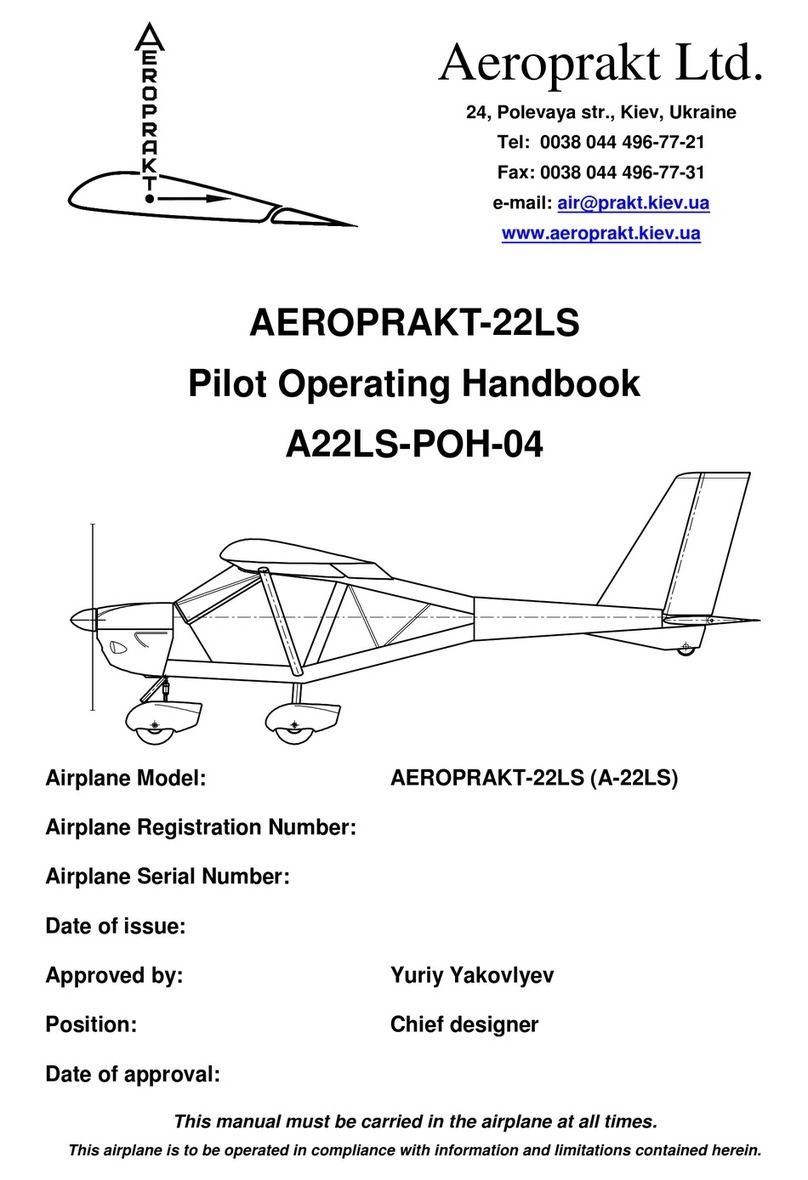
AEROPRAKT
AEROPRAKT A22LS Owner's manual
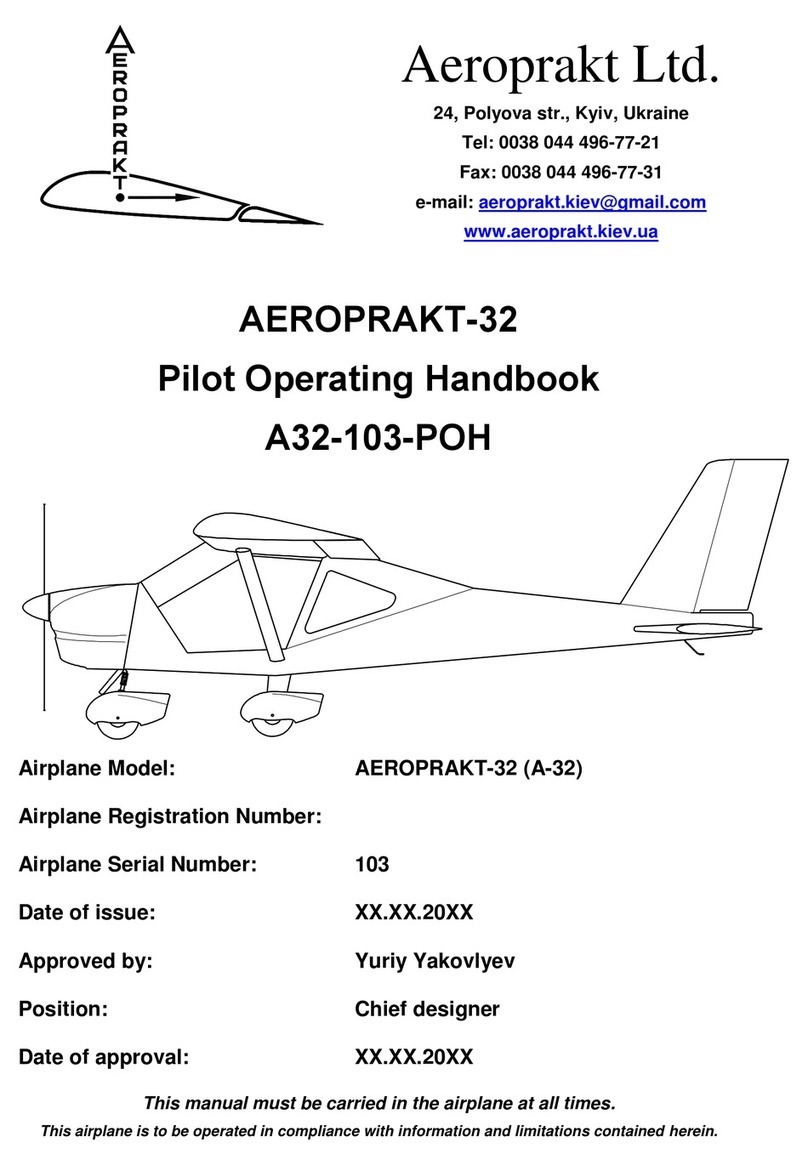
AEROPRAKT
AEROPRAKT A32-103-POH Owner's manual
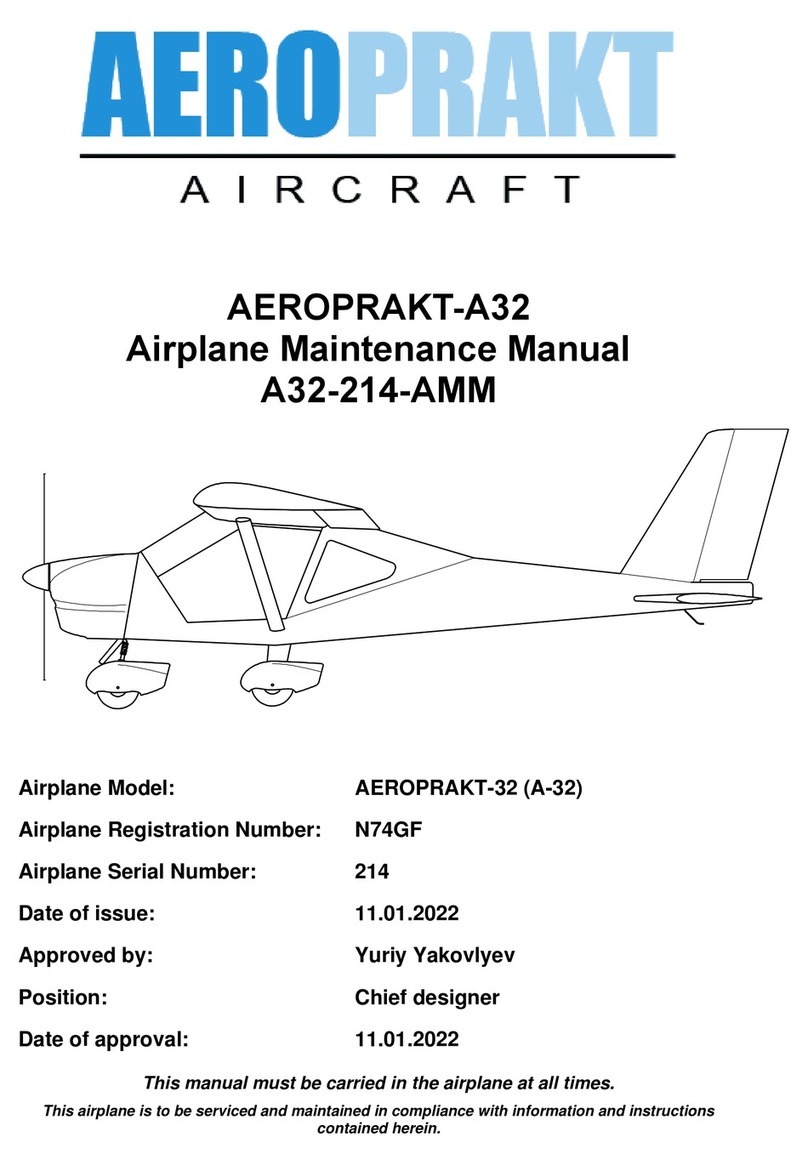
AEROPRAKT
AEROPRAKT A32 User manual
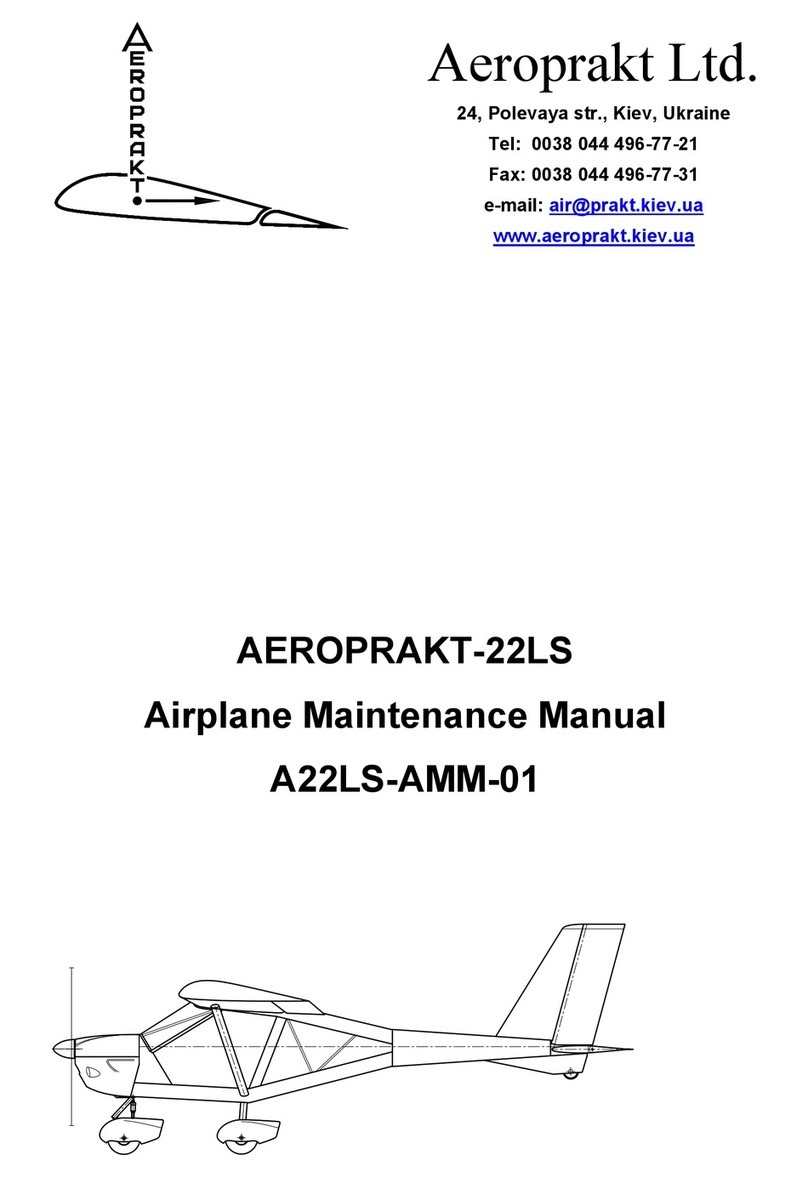
AEROPRAKT
AEROPRAKT A22LS User manual
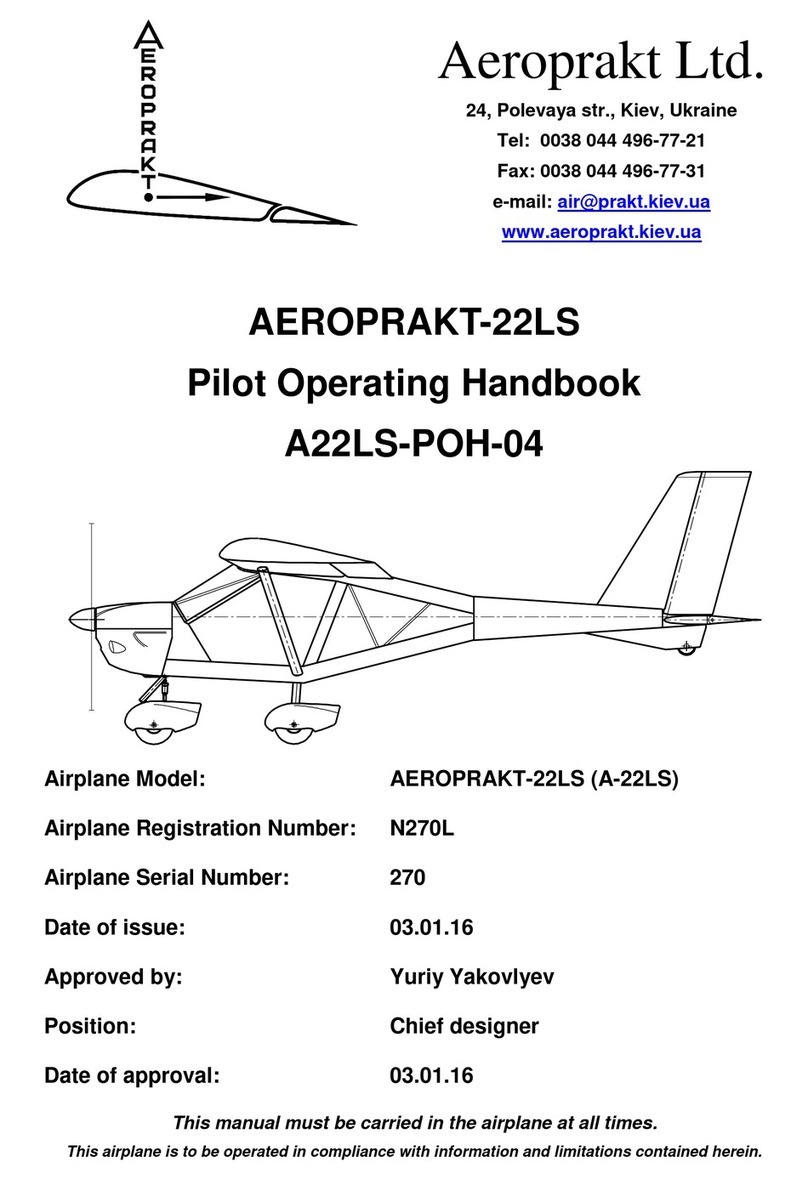
AEROPRAKT
AEROPRAKT A22LS-POH-04 Owner's manual
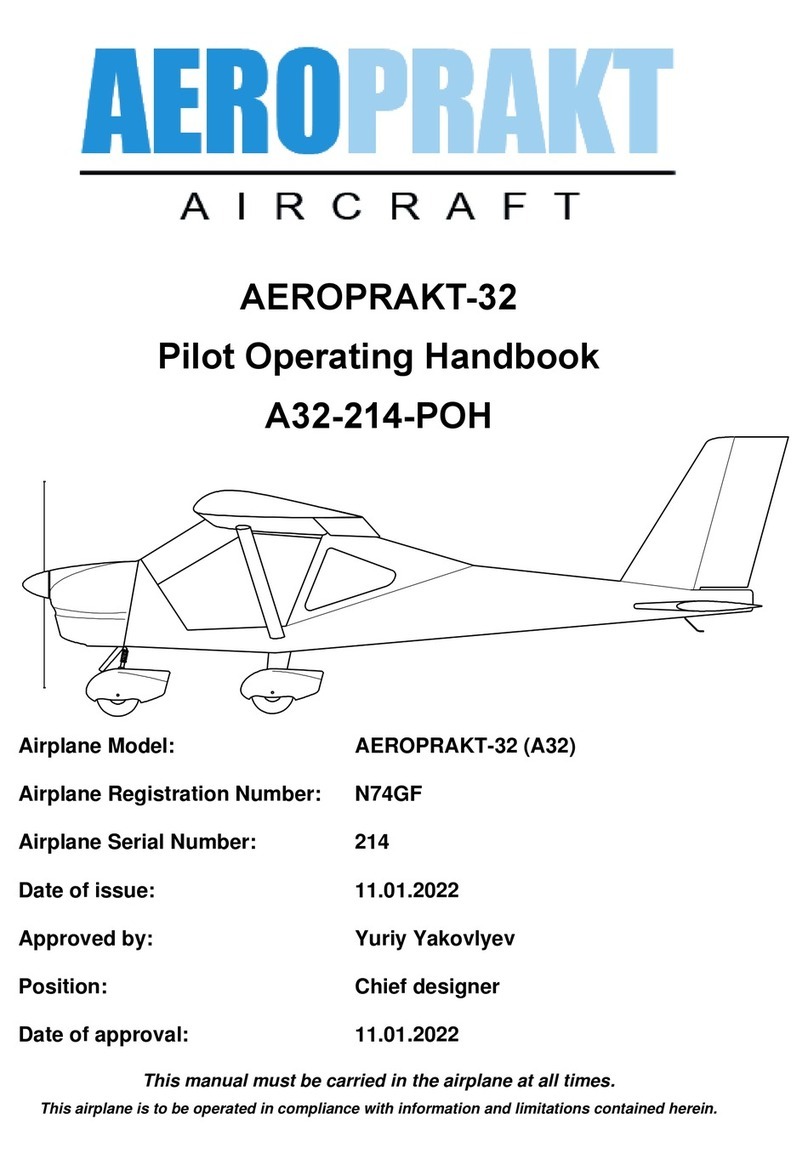
AEROPRAKT
AEROPRAKT A32-214-POH Owner's manual

AEROPRAKT
AEROPRAKT A32-029-POH Owner's manual
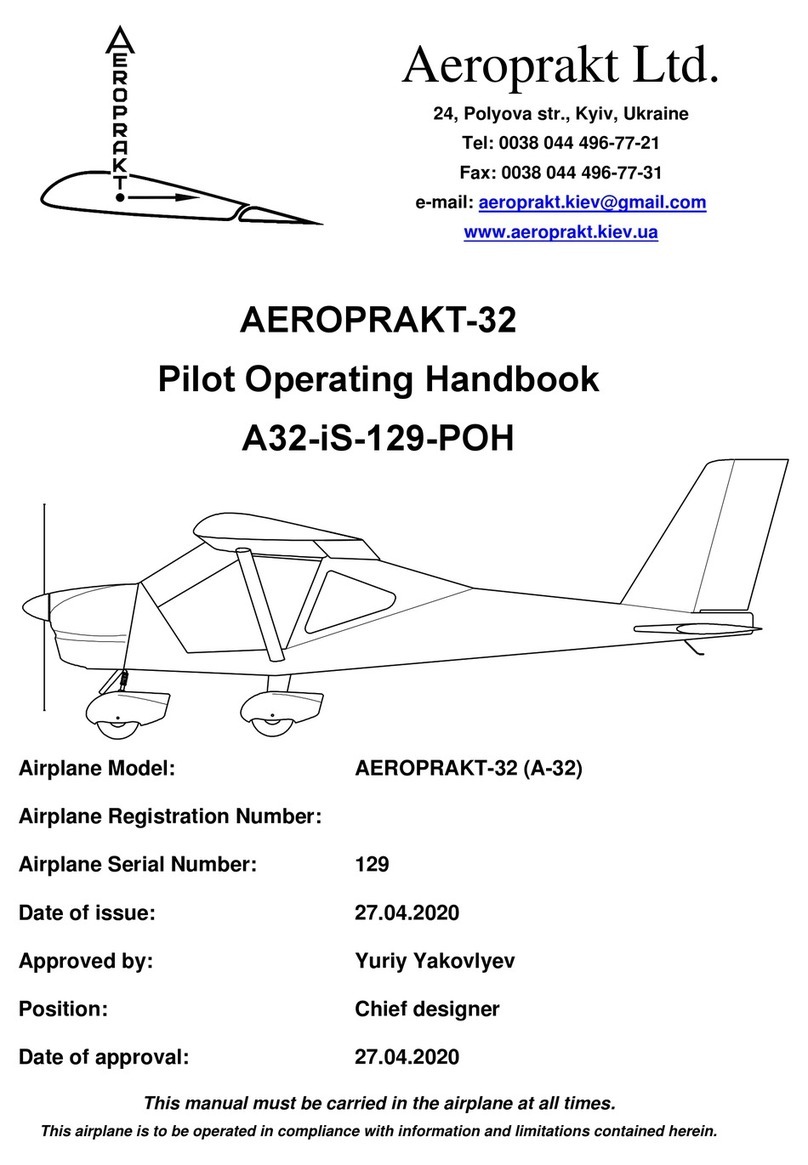
AEROPRAKT
AEROPRAKT A32-iS-129-POH Owner's manual

AEROPRAKT
AEROPRAKT A32 Owner's manual

AEROPRAKT
AEROPRAKT AEROPRAKT-32 User manual
